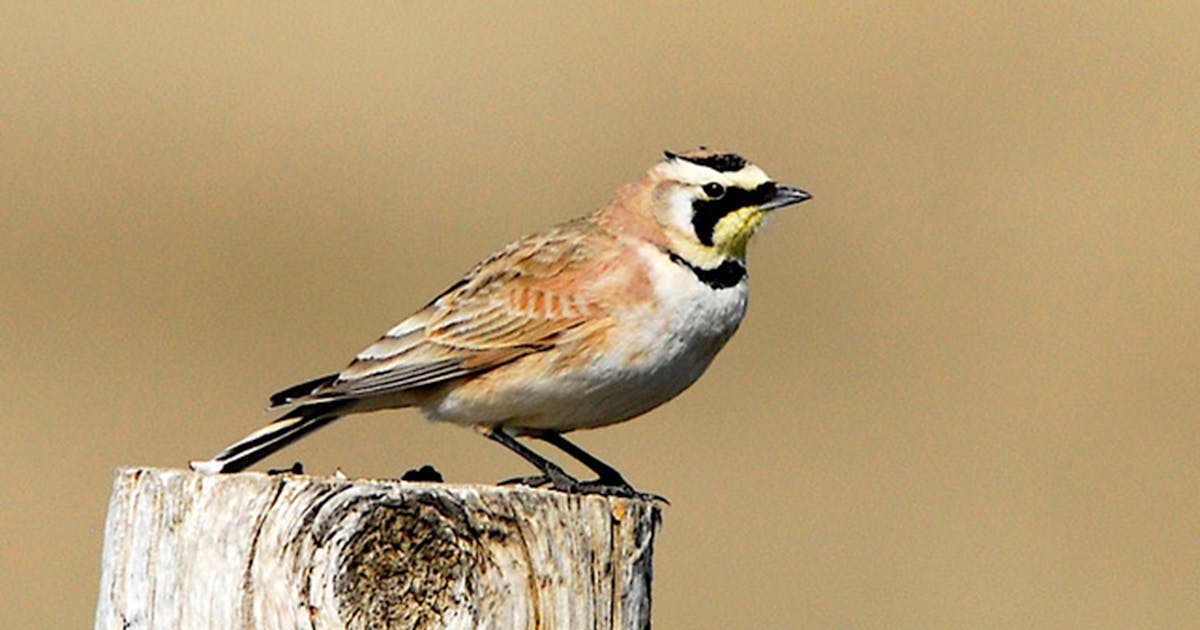Q: I want to see new bird faces! What are the first birds to return in the spring?
A: The Horned Lark is one of the first birds to take flight from its winter home. You might spot them on farm fields and roads outside of town starting in early February. Look for other early birds like sandhill cranes which head for nesting areas from early March, the same time red-winged blackbirds assert their claim to wetlands, and common grackles and great blue herons begin to appear around St. Patrick’s Day. A sure sign that spring is on the way is the sight of red-headed vultures hovering overhead anytime after the third week of March. If you think of birds with pretty songs, the arrival of the first Meadowlarks in open grasslands, like Lake Elmo Park Preserve and the Three Rivers Park District parks, in mid-April will lift your spirits. moral.
Housing for ‘dees
Q: I received a birdhouse for wrens or tits, the tag says, as a holiday gift. When should I put it outside?
A: I would say right away, since tits are early nests and are already prospecting good places to raise a family. It is best to mount these birdhouses on a post away from tree branches and shrubs, and place a squirrel guard on the post or post so that predators like squirrels and cats cannot shine to claim a easy meal. The wrens return from migration a bit later, and if the chickadees are lucky they will have left their brood before a wren tries to commandeer the box.
Up early?
Q: Saw a red tailed hawk in a local park and it’s been hovering lately. Isn’t it early in the year for this hawk?
A: It’s likely that the red-tail you see has been around all winter because red-tails are what are called “partial migrants”, meaning some are migratory and some are not. Most of these beautiful falcons head to southern regions to overwinter, but some stay year-round, regardless of the weather.
hummingbird fever
Q: I want to be ready the minute the hummingbirds come back to town. When should I plan to take out my nectar feeder?
A: I like your intentions, and you could hang your nectar feeder outside from the third week of April, when the first arrivals start to pass. If you want to track the progress of Ruby-throated Hummingbirds after crossing the Gulf of Mexico this spring, check this website occasionally for frequently updated maps: www.hummingbirdcentral.com. And don’t forget the Audubon Society’s Hummingbirds at Home site, a citizen science project where you can report hummingbird sightings, to help researchers get a sense of how climate change is affecting small birds: www.audubon.org/content/hummingbirds-home.
White-headed Grosbeak
Q: There is a female bald cardinal who comes to my feeders. It seems so strange and I wonder: what is the cause?
A: I bet this bird is a striking sight, and while it’s not common, people occasionally report cardinals with white heads or white body patches. There is some disagreement as to whether this is caused by genetic mutation or damage to a bird’s pigment cells during development. The condition is called leucism and is different from albinism. I checked the Cornell Lab of Ornithology’s Project FeederWatch site, where there are quite a few reports and photos of bald cardinals, and, like yours, many of them are female.
More harm than help
Q: I hope you can help me with a problem with my neighbor: He insists on spilling dog and cat food in his driveway. He shovels this food every day and it attracts crowds of crows and all kinds of critters like foxes, squirrels, rats and raccoons. He says he does it to help the birds, but since he’s been doing this (for years) we haven’t seen any cardinals or other songbirds. I have spoken to my city about it but there has been no help so far. What else can we do?
A: It’s an unhealthy situation and I find it amazing that your city allows it to continue. Some municipalities prohibit feeding animals on the ground specifically to prevent rat infestations, and you noticed another neighbor has videos of rats among the animals feeding on the kibble. I suggest you contact the city again, as well as your city council representative, to show them the videos and ask the city to intervene.
Cat and dog kibble aren’t exactly appealing to songbirds, and the presence of so many other large birds and mammals discourages them from visiting. I hope your city will assign a health inspector to this problem. In the meantime, could you and other neighbors invest in a good bird feeder and some seed and give it to your neighbor, tactfully suggesting that it will be better for the birds?
Seedball Avoidance
Q: We had lots of birds at our feeders including finches, cardinals, sparrows and chickadees. But we recently hung a ball of seeds near a window and only the tits feed on it. Is there a reason other birds avoid it?
A: Chickadees are fearless little birds and are almost always the first to try a new food source, so it’s no surprise that they tried the seed ball, loved it, and kept coming back. Other birds might not want to come near your house to feed – they may see movement inside the house and decide not to venture there. While they visit your other feeders, the chickadees will be happy to have a new feeder all to themselves.
St. Paul resident Val Cunningham, who volunteers with the St. Paul Audubon Society and writes about nature for local, regional and national newspapers and magazines, can be reached at [email protected].

